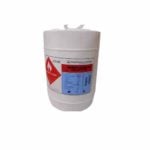Table of Contents
Here we’ll discuss some of the ingredients, alcohol quality, and variables which will help you identify premium and high quality alcohol for sanitation products. Second, we’ll include some info on where you can find FCC and USP grade alcohol online. There are a couple things to consider for the best price and value, especially when making bulk purchases for large facilities or events.
What’s More Effective Against the Flu Virus? Ethanol or Isopropyl Alcohol?
Why Are Alcohols Effective for Sanitation?
Alcohol-based hand rubs have evidence-based advantages for formulating a fast acting, broad-spectrum sanitizer. The two most common alcohol for sanitation purposes are ethanol (ethyl alcohol) and isopropyl alcohol (isopropanol).
Importantly, alcohol content does impact the ability of the active ingredient to kill bacteria, fungi, and viruses.
Sanitizer Alcohol Percentage
The most widely recognized concentration of hand sanitizer is between 62% – 90% alcohol by volume. Outside of theses percentages the efficacy rapidly falls off.
Studies show that the alcohol concentration is an important factor for reducing bacterial forming units.
The World Health Organization suggests that 70% ethyl alcohol is superior to isopropyl alcohol against the influenza virus, however, both provide adequate germicidal properties.
Ethanol is recommended at higher % concentration, usually 80%. It’s widely recognized that ethanol in this concentration is effective against many viruses and bacteria.
Read More: Is Ethanol the Secret Weapon Against COVID-19?
75% vs 80% Ethanol Hand Sanitizer
Why Is Hand Sanitizer Either 75% Isopropyl Alcohol or 80% Ethanol?
As a precaution, sanitizer is produced with higher alcohol content than necessary for sanitation purposes. Higher concentrations of alcohol does not necessarily kill more bacteria, however it does safe guard against impotent ingredients, evaporation loss, and margin of error.
Sanitizer formulations usually feature either isopropyl alcohol or ethyl alcohol (ethanol) as active ingredients. Alcohols are widely recognized as effective against vegetative bacteria and enveloped viruses. Common enveloped viruses include the flu and coronaviruses.
There are many factors which influence alcohol efficacy against a target pathogen or microbe including contact time, specimen medium, immediate environment, and method of testing.
Percentage Isopropyl Alcohol vs Ethyl Alcohol
The differences between ethanol and isopropyl alcohol percentages are something we’ve addressed at depth in a previous post.
Related: Why is 70% a More Effective Sanitizer than 99%?
The percentage of alcohol differs between isopropyl alcohol (IPA) ethanol (ethyl alcohol) because their chemical properties differ and can be more effective against a target microbe in varying concentrations.
Ethanol and Isopropyl Alcohol Studies
The studies below demonstrate how alcohol type, alcohol concentration, and environmental conditions influence the usefulness of alcohols against germs, viruses, and pathogens. One should not assume that if a chemical is affective against one virus that it will be affective against all viruses.
Does alcohol kills germs and viruses?
Isopropyl alcohol is effective against viruses such as FCV at 40% – 60% concentrations. Ethanol however, is more effective at 70% – 90% concentrations against FCV.
In other cases, isopropyl alcohol is more effective than ethanol at lower percentage concentrations. For example, IPA is more effective against tubercle bacilli in dried smears, or vaccinia viruses suspended in chick embryo material. (pg. 240)
Experiments show that anaerobic bacteria are capable of surviving 10 months in an ethanol suspension at 10% concentrations, but only 4 weeks in 40% to 80% concentration. (pg. 239)
Contact time indicates how effective an alcohol is against a target microbe in a given period of time. A chemical with a short contact time will deactivate the virus or bacteria quickly, usually in less than 30 seconds – 1 minute.
A long contact time means that the virus or bacteria is able to survive for extended periods, sometimes for days, weeks, or months.
Studies on the Efficacy of Ethanol for Sanitizer
The WHO suggests that the ideal ethanol concentration of hand sanitizer by volume should be between 75 and 85%, with a target of 80%.
Depending on the design, scope, and target microbes, the results of any single efficacy test or study vary.
Study: 62% Hand Sanitizer Gel More Effective than 40% Ethanol Gel
40% ethanol, tap water, and 40% ethanol gel produced no significant reductions of germs and bacteria. The 40% gel supplemented with ethanol to a final concentration of 62% reduced the mean CFU by 90%, a level of reduction similar to that of the 62% ethanol gel.
Journal of Emerging Infectious Diseases . 2006 Mar; 12(3): 527–529
Study: 40% Ethanol Still Shown Affective Against Coronavirus
“Of considerable relevance to our current situation, a study was published in 2017 documenting the impacts of different strengths of the WHO formulation on a range of enveloped viruses, including MERS-CoV and SARS-CoV, causative agents of the Middle East Respiratory Syndrome (MERS) and Severe Acute Respiratory Syndrome (SARS). This study demonstrated high susceptibility of these virus types to hand-rub formulations as low as 40% ethanol by volume in suspension tests, which do not typically reveal surface porosity impacts (10).”
Production of Ethanol‐Based Hand Sanitizer – MBAA TQ vol. 57, no. 1 • 2020
Read More: Studies Evaluating the Efficacy of Ethanol as a Surface Disinfectant for Flu and Viruses
Ethanol Hand Sanitizer Grades – FCC vs USP Grade Ethanol
NOTE: Ethanol with an FCC grade rating does not imply that the alcohol is fit for human consumption. Virtually all FCC grade ethanol sold is bulk is denatured, which renders it undrinkable.
FCC Alcohol
FCC accreditation is considered a gold standard of ethanol quality and purity. The Food Chemical Index requires all the standards of USP grade alcohol with the additional requirement that the alcohol is evaluated for heavy metal specification limits.
FCC grade ethyl alcohol (Food Chemical Codex) in its absolute and unaltered form, the alcohol is appropriate for use in the manufacturing and consumption of food and beverages.
Note: What Should I Do If I Suspect Methanol Exposure, Poisoning, or Toxicity?
Need help now? Call 9-1-1 if the person is unconscious or has trouble breathing. Call Poison Help at 800-222-1222 to connect to your local poison center. Learn more at https://poisonhelp.hrsa.gov/.
USP Grade Ethanol
The requirements and standards for USP grade ethanol are covered in part with USP chapter <467> residual solvents.
USP grade alcohol is used for the production of pharmaceuticals, supplements, a slightly less stringent standard which is appropriate for food-grade surfaces and production environments, but not something suitable for human consumption. USP grade ensures that ethanol is validated for purity and potency.
Because of concerns over methanol byproducts in sanitizer products, the FDA has recommended that methanol testing limits now be included within USP standard compliance.
70% Denatured Ethanol for Surfaces and Objects
Presaturated ethanol spray (ethyl alcohol) is a common surface decontamination products for pharmaceuticals, healthcare, and medical device manufacturing.
Ethanol is low-level disinfectant considered highly effective against most common viruses.
Clean surfaces, gloves, notebooks, phones, equipment, or any compatible material. Use alcohol with care: may degrade some types of plastics, display surfaces, and enamels.
Ethanol Purchasing Regulations
What are the Disadvantages of Ethanol Hand Sanitizer
Ethanol is a volatile, flammable substance and should be handled with care. Large orders, such as ethanol by the barrel or tanker truck require appropriate permits and hazardous shipping charges. If ingested, ethanol can be toxic and cause impairment.
The FDA regulates hand sanitizer as an over-the-counter drug, available without a prescription.
Sanitizers and disinfectants require strict labeling and are regulated by the EPA. For on label claims, manufacturers must provide the specific germs in which the chemical is capable of targeting. Currently, some restrictions on essential hand sanitizer products have been lifted in order to ensure access for the population at large.
Specially Denatured Alcohols (SDA):
Its extremely important to recognize the differences between denatured ethanol and non-denatured ethanol. Denaturants render a substance unpalatable and undrinkable.
What is Denatonium Benzoate?
Specially denatured ethanol is ideal for hand sanitizer, as the ethanol itself is very pure, however it’s also denatured with bitterants that make it unpalatable. Denatonium benzoate is a common bittering agent which is known to reduce accidental poisoning.
Ethanol Sanitizer Prices
Where Can I Buy Ethanol for Hand Sanitizer Production?
“We have denatured FCC grade ethanol ready to be loaded in bulk shipments. Specially denatured spirits (SDS 40b) are the preferred FDA formula for producing hand sanitizer. The 190 proof alcohol is denatured with denatonium benzoate. Ethanol tankers deliver a minimum load of 2000 gallons. The max load is 7000 gallons.”
Travis Martin – PAC Technical Sales Team – Ask for Help with A Purchase
Alcohol and Tobacco Tax and Trade Bureau TTB permit is required for this material and will be required at the time of purchase. Information on this process can be found here.
Have a specific question about the efficacy of ethanol or isopropyl alcohol? Send us an email or leave a comment below.
Related Posts
-
What is the Shelf Life of Isopropyl Alcohol (IPA)? Does it Expire?
Does Isopropyl Alcohol (IPA) expire and what is the shelf life? How do I store it?
-
Why Is 70% Isopropyl Alcohol (IPA) a Better Disinfectant than 99% Isopropanol, and What Is IPA Used For?
How does one solution kill viruses and bacteria on contact, and the other not at all?
-
70% Alcohol Battles Against Super Bacteria?
New reports indicate that alcohol hand washes and sanitizers may be losing the hygiene battle against super strains of Enterococcal bacterial.
-
Ethanol & Isopropyl Alcohol: Your Questions Answered
The internet's guide to frequently asked questions about Isopropyl alcohol. Find answers to questions about IPA use, sanitizers, and dilution.
-
Ethanol & Isopropyl Alcohol: Your Questions Answered
The internet's guide to frequently asked questions about Isopropyl alcohol. Find answers to questions about IPA use, sanitizers, and dilution.
-
Ethanol & Isopropyl Alcohol: Your Questions Answered
The internet's guide to frequently asked questions about Isopropyl alcohol. Find answers to questions about IPA use, sanitizers, and dilution.
-
The Dangers of Isopropyl Alcohol
Hazards of Isopropyl Alcohol (IPA) As we’ve discussed in a previous post, there are many advantages of using isopropyl alcohol in the manufacturing process because of its low cost, but what we didn’t cover is some of…
-
We Sell The Highest Grade 99% Isopropyl Alcohol By The Gallon. Here's How To Get The Best Price Online.
For any use of isopropyl alcohol, it's essential that the advertised contents reflect the actual reality of the solution. Water to alcohol concentration is a key indicator of efficacy and usefulness of IPA. Quality solvents…
-
What is the Shelf Life of Isopropyl Alcohol (IPA)? Does it Expire?
Does Isopropyl Alcohol (IPA) expire and what is the shelf life? How do I store it?
-
Why Is 70% Isopropyl Alcohol (IPA) a Better Disinfectant than 99% Isopropanol, and What Is IPA Used For?
How does one solution kill viruses and bacteria on contact, and the other not at all?
-
New: Perfex Cleanroom Mop & Disinfection Systems
Perfex cleanroom mop and disinfection systems are designed for easy use and maintenance for critical operations. It's the cleaning performance you'd expect beyond old-style buckets, wringers, string and sponge mops.
-
Types of Cleaners | Disinfectants for Industrial, Hospitals, or Medical Devices. How Are They Used?
This article defines, contracts, and compares FDA and EPA requirements for the efficacy of various chemical germicides, sterilants, and disinfectant chemicals.
-
Ethanol & Isopropyl Alcohol: Your Questions Answered
The internet's guide to frequently asked questions about Isopropyl alcohol. Find answers to questions about IPA use, sanitizers, and dilution.
-
The Dangers of Isopropyl Alcohol
Hazards of Isopropyl Alcohol (IPA) As we’ve discussed in a previous post, there are many advantages of using isopropyl alcohol in the manufacturing process because of its low cost, but what we didn’t cover is some of…
-
We Sell The Highest Grade 99% Isopropyl Alcohol By The Gallon. Here's How To Get The Best Price Online.
For any use of isopropyl alcohol, it's essential that the advertised contents reflect the actual reality of the solution. Water to alcohol concentration is a key indicator of efficacy and usefulness of IPA. Quality solvents…













